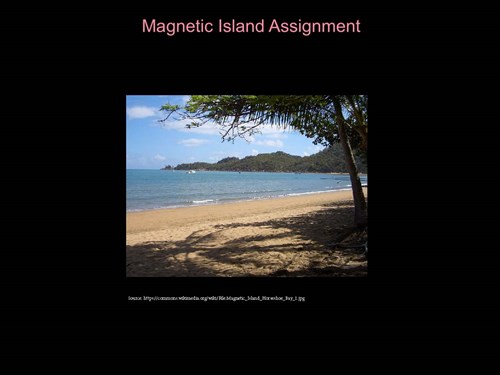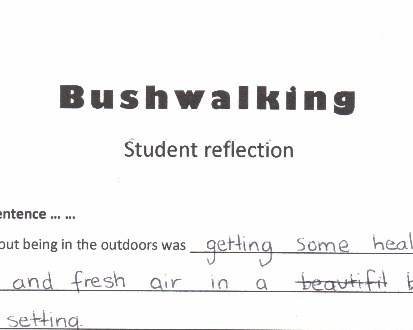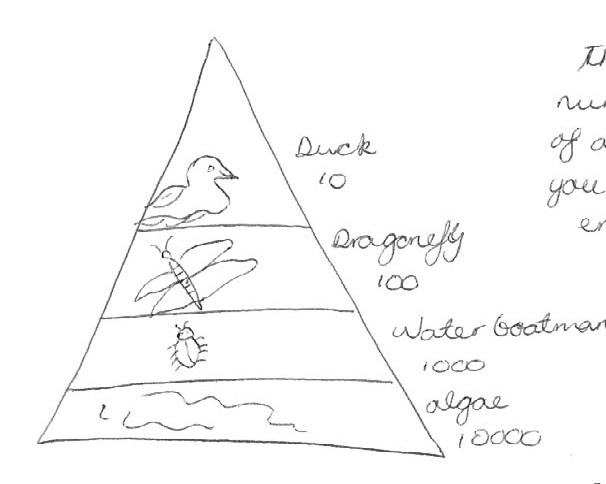Outdoor learning
Introduction
The outdoor learning connection provides a framework for students to experience guided, integrated learning across the curriculum in natural environments. Students have the opportunity to gain unique and specific benefits from outdoor learning. They develop skills and understandings while valuing a positive relationship with natural environments and promoting the sustainable use of these environments.
This connection presents four dimensions, which have been developed in consultation with Outdoor Education Australia. Content related to outdoor learning in the Australian Curriculum can be delivered in a range of ways; some of these are outlined under models of delivery.
The following pages show how content from the Australian Curriculum: Health and Physical Education, Humanities and Social Sciences, Geography, Science, general capabilities and cross-curriculum priorities can be organised and delivered through learning in the outdoors (F–6) and outdoor education (7–10).
Links are also provided to relevant student work samples which illustrate student learning in relation to achievement standards.
The development of positive relationships with others and with the environment through interaction with the natural world can be facilitated through outdoor learning. These relationships are essential for the wellbeing and sustainability of individuals, society and our environment. Outdoor learning engages students in practical and active learning experiences in natural environments and settings, and this typically takes place beyond the school classroom. In these environments, students develop the skills and understandings to move safely and competently while valuing a positive relationship with natural environments and promoting the sustainable use of these environments.
Outdoor learning not only addresses content across several learning areas, it is also uniquely placed to address general capabilities and cross-curriculum priorities of the Australian Curriculum. In particular, these are Personal and Social Capability, Critical and Creative Thinking, Ethical Understanding, Aboriginal and Torres Strait Islander Histories and Cultures, and Sustainability.
Outdoor learning can be instrumental in:
- the teaching and learning of self-reliance, interdependence and leadership
- the development of an adventurous spirit
- managing personal risks
- experiencing safe journeys in nature
- learning the value of lifelong outdoor recreation for enjoyment, health and wellbeing
- understanding nature through direct experience; and the development of deeper human–nature relationships.
Any learning experience that can be undertaken in the outdoors or in a natural setting can contribute positively to a range of learning areas. The unique and specific benefits that outdoor learning can contribute to a student’s education include:
- providing direct personal contact with nature (the outdoors) in ways that promote enjoyment of outdoor activity and the natural world. Such enjoyment can be the basis for ongoing outdoor recreation and nature experiences, supporting personal health and wellbeing and providing the foundations for ecological literacy.
- enabling perspectives on contemporary living and human-to-nature relationships. Through the provision of outdoor experiences, students have opportunities to reflect on healthy alternatives for everyday living and lay vital foundations for sustainability and stewardship into the future.
- developing competence and safety management in the Australian outdoors. This includes how outdoor learning can teach students to assess risk and make judgements about their management of it.
- enhancing wellbeing through guided reflection on involvement in group and individual activities that are challenging and adventurous.
- developing essential personal and social capabilities such as communication, resilience, self-confidence, leadership, teamwork, goal setting, personal autonomy and initiative.
To maximise the effectiveness of any outdoor learning delivered in schools, learning should be sequential and have clearly aligned themes and specific links to curriculum. The four dimensions of this learning are:
- Skills and knowledge
- Human–nature relationships
- Conservation and sustainability
- Health and wellbeing
1. Skills and knowledge
A range of skills and knowledge is needed to work together and be active and safe in the outdoors.
As students spend time learning in nature about safe travel and experiences, they develop a broad range of skills that contribute to a deep understanding of the potential hazards inherent in a range of environments. They learn that investigating environments in a safe way, planning and preparing, being organised, working together, having a leadership structure and having an incident response plan are important skills and responsibilities for those who spend time in natural environments. In this way, students learn to foster their adventurous spirit while engaging in healthy, non-competitive, lifelong physical activities.
2. Human–nature relationships
An individual’s experience in natural environments enhances human–nature relationships.
Educational time in nature allows students to develop multiple ways of knowing and creates strong connections to natural environments. With repeated visits and multiple ways of engaging with natural environments, students learn to appreciate nature as a health-giving resource rather than a danger.
3. Conservation and sustainability
Ecological, cultural and personal knowledge of and experiences in nature enhance decision-making about conservation and sustainability.
Time invested in learning about scientific, western cultural, Aboriginal and Torres Strait Islander cultural, economic, recreational and aesthetic knowledge provides a foundation for the critical analysis of human interaction with the natural world. Students investigate strategies to reduce the local and global impact of human activity on natural environments and engage in actions that positively contribute to conservation and sustainable living.
4. Health and wellbeing
Experiences in natural environments promote personal growth and development, and health and wellbeing.
Students experience the deep personal impact of time in nature. This includes the role of natural environments in providing a balance to modern, technologically intense living and in supporting physical, social, emotional, mental and spiritual wellbeing. Students are given unique opportunities to reflect on their own and with others about themselves, their relationship with others and their place in the world.
These dimensions of learning have been developed in consultation with Outdoor Education Australia (OEA).
Identifying and managing risk in outdoor learning needs to take into account the minimum standards of planning, personal protective equipment and qualifications or experience of teachers and leaders. It covers all necessary aspects of health, safety and injury prevention and, in any outdoor learning context, the use of equipment.
Outdoor learning experiences may involve potentially hazardous activities. It is important to ensure that duty of care is exercised and that requirements of the Work Health and Safety Act 2011 are met, in addition to relevant state or territory health and safety guidelines.
Consult with your state/territory education authority regarding local laws and policies about conducting learning experiences off-campus.
ACARA respectfully acknowledges the Traditional Custodians of the land, their Elders past and present, for the important and enduring role that Aboriginal and Torres Strait Islander peoples play in Australia. In particular, ACARA respectfully acknowledges the important and enduring role of Aboriginal and Torres Strait Islander peoples and their cultures in regard to the land, water and sky used for learning in the outdoors.
Content related to outdoor education in the Australian Curriculum can be delivered in a range of ways including the following:
As a sequential, standalone subject
Students in secondary schools may elect to undertake outdoor education as a standalone subject, taught by teachers from within the school. Students learn through direct teaching in the classroom enhanced by personal experiences outside the classroom in local environments as well as journeys to and through nearby natural environments.
As an annual, sequential field trip and camps program that may allow components of other learning areas to be taught
Students achieve deep learning through a planned sequence of year-level camps programmed each year. In the early primary years, students may take part in a sleepover with parents/caregivers on the school grounds, followed by residential and under-canvas camps, culminating in a more extensive journey to a nearby natural environment. The camps can include learning from a range of curriculum areas.
As a teaching methodology learning in, about and for the outdoors, drawing on content from a range of learning areas
Each learning area examines how they might use outdoor learning as part of the delivery of their curriculum. This may include using outdoor journeys as ways to engage in local environments to explore concepts that have been investigated in the classroom. This might involve one or more learning areas combining to achieve linked outcomes. Students plan and complete an outdoor journey as the culminating experience to demonstrate their learning in a range of learning areas.
Children & Nature Network 2016, Green Schoolyards for Healthy Communities: Building a national movement for green schoolyards in every community, USA. Available from: http://www.childrenandnature.org/wp-content/uploads/2015/03/CNN_GSY_Report2016_Final.pdf
Children & Nature Network 2017, Green Schoolyards: Partnerships and pilot programs. http://www.childrenandnature.org/initiatives/schoolyards/
Children & Nature Network (various dates), Research and Studies, volumes i–vi.
Volume iii, September 2008. Available from: https://issuu.com/childrenandnature/docs/cnnrsrchvol_03
Volume iv, September 2009. Available from: https://issuu.com/childrenandnature/docs/cnnrsrchvol_04
Dickson, TJ, Gray, T & Mann, K for the Outdoor Council of Australia 2008, Australian Outdoor Adventure Activity Benefits Catalogue, University of Canberra.
https://www.academia.edu/8370828/Dickson_T._Gray_T._and_Mann_K_2008_._Australian_Outdoor_Adventure_Activity_Benefits_Catalogue_http_outdoorcouncil.asn.au_doc_OutdoorActivityBenefitsCatalogueFinal270808.pdf
Froude, C and Polley, S 2011, Outdoor Education: Foundations for tertiary and senior secondary education, 2nd edn, Impact Publishing, Cottesloe, WA.
Gray, T 2012, ‘Vitamin N: The missing ingredient in the 21st century curriculum’ in 21st Century Learning blog, 15 July 2012, Western Sydney University.
http://learning21c.wordpress.com/2012/07/15/vitamin-n-the-missing-ingredient-in-the-21st-century-curriculum/
Gray, T 2013, ‘Overcoming ecophobia’, Wildlife Australia, Summer 2013, pp. 42–44. https://www.academia.edu/5471946/Overcoming_Ecophobia_December_2013
Gray, T 2015, ‘Anaesthetized by screen or energized by green?’ in 21st Century Learning blog, 4 August 2015, Western Sydney University.
https://learning21c.wordpress.com/2015/08/04/anaesthetized-by-screen-or-energized-by-green/
Gray, T & Martin, P 2012, ‘The role and place of outdoor education in the Australian National Curriculum’, Australian Journal of Outdoor Education, vol. 16, no. 1, pp. 39–50.
Kellert, S 2013, ‘Children, nature and the future of our species’, in 21st Century Learning blog, 8 April 2013, Western Sydney University.
http://learning21c.wordpress.com/2013/04/08/children-nature-and-the-future-of-our-species/
Malone, K & Waite, S 2016, Student Outcomes and Natural Schooling, Plymouth University, Plymouth, UK. Available online: http://www.plymouth.ac.uk/research/oelres-net
Planet Ark 2014, National Tree Day: Health benefits. http://treeday.planetark.org/about/health-benefits.cfm
Townsend M & Weerasuriya R 2010, Beyond Blue to Green: The benefits of contact with nature for mental health and well-being, Beyond Blue Limited, Melbourne. Available from: https://www.deakin.edu.au/__data/assets/pdf_file/0004/310747/Beyond-Blue-To-Green-Literature-Review.pdf
MacGibbon, A 2010, ‘Children respond to call of the wild’, May 10 2010, Sydney Morning Herald. Available at:
http://www.smh.com.au/national/education/children-respond-to-call-of-the-wild-20100509-ulqv.html
NSW Department of Education – Learning Systems, Engaging children in nature: interviews with Richard Louv (5-part series)
http://www.youtube.com/watch?v=XJRQRDNliNE&list=PL4OaBCdO34bCqGmYtAskZqtvi0uMuYnef
The Wild Network, Project Wild Thing






